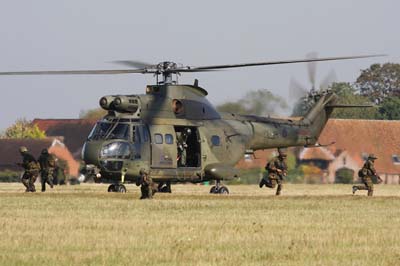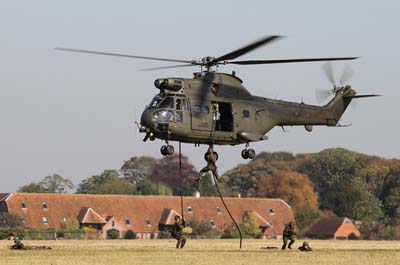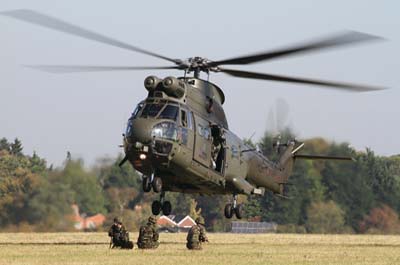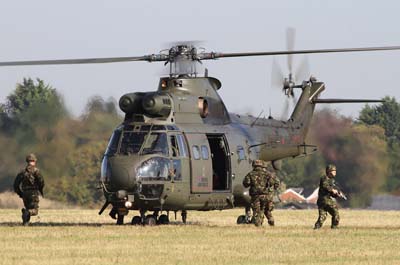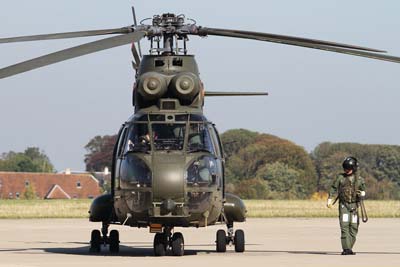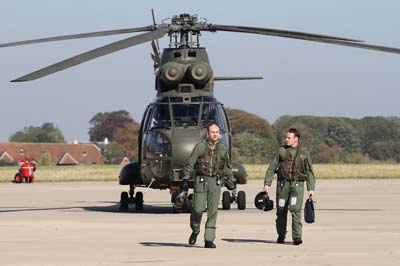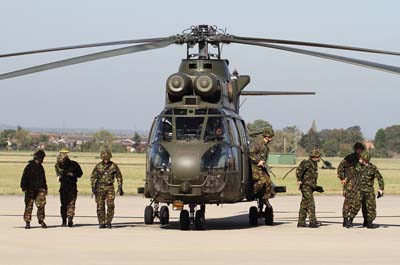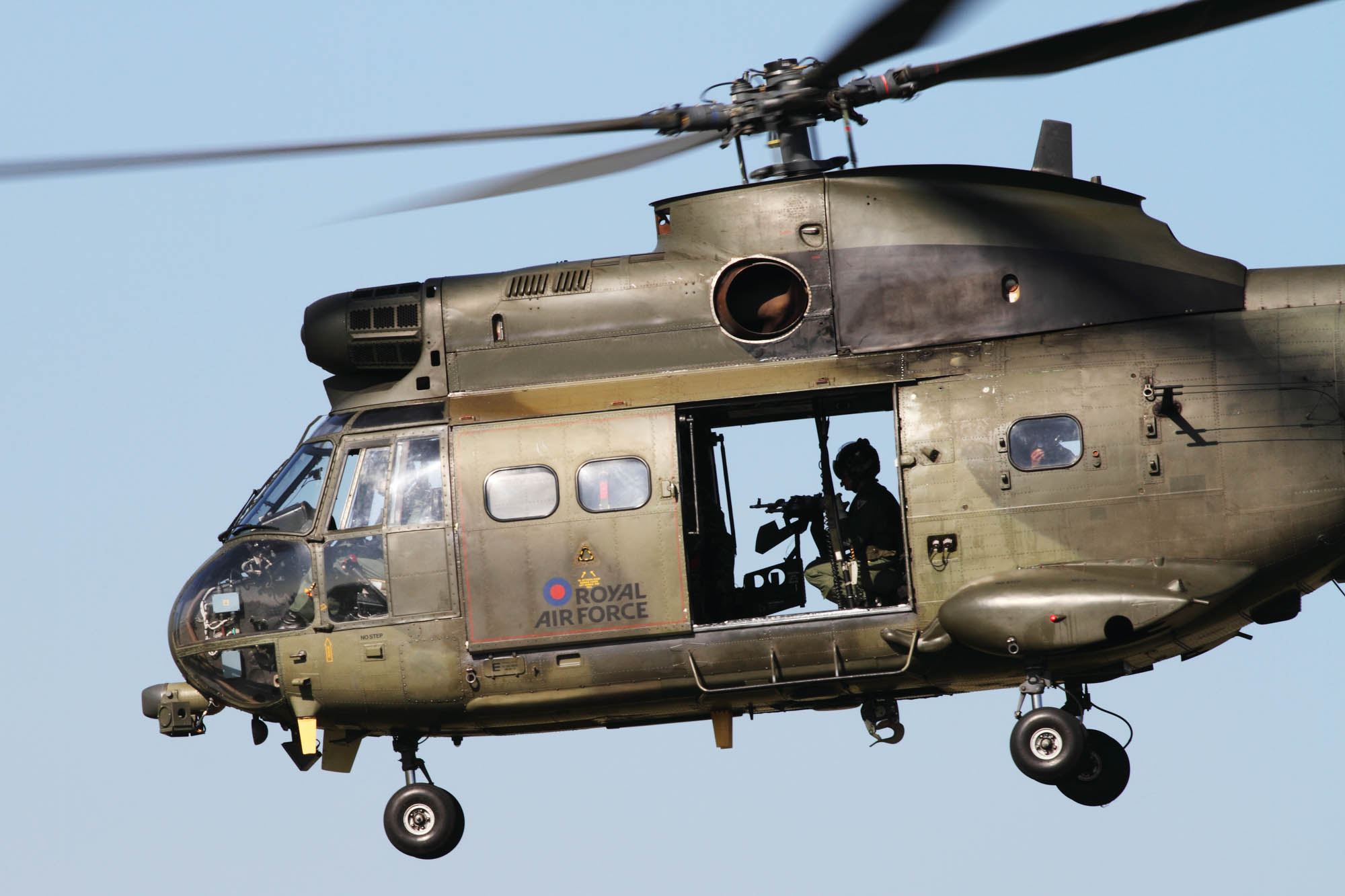Puma 40th Anniversary
RAF Benson
September 2011
|
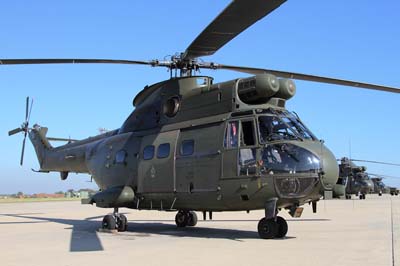
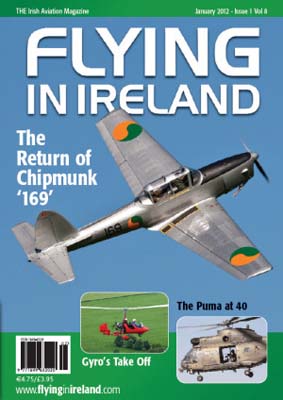 Philip Stevens for Flying in Ireland reports:
The first operational flight of the Westland Puma HC.1 was made on September 29, 1971. Since entering service with the Royal Air Force this helicopter has provided transport and protection for troops and civilians alike. It has performed consistently well in the last 40 years in both arctic and tropical conditions for military and humanitarian operations across the world notably in; Norway, Belize, Kenya, Kosovo, Mozambique, Zimbabwe, Northern Ireland and Iraq.
Philip Stevens for Flying in Ireland reports:
The first operational flight of the Westland Puma HC.1 was made on September 29, 1971. Since entering service with the Royal Air Force this helicopter has provided transport and protection for troops and civilians alike. It has performed consistently well in the last 40 years in both arctic and tropical conditions for military and humanitarian operations across the world notably in; Norway, Belize, Kenya, Kosovo, Mozambique, Zimbabwe, Northern Ireland and Iraq.
A versatile role
The Pumas are utilised as battlefield helicopters to provide tactical movement of troops, weapons, ammunition and support stores by day or by night. It can carry up to 16 fully-equipped troops, or up to two tonnes (3,200 kg) of freight carried either internally or as an underslung load (USL). Another major capability is that of casualty or medical evacuation (CASEVAC) from forward areas, when up to six stretchers can be transported. The Puma can also fulfil a Search and Rescue (SAR) role encompassing the locating and evacuation of people in emergency situations. For either arctic warfare or desert warfare specialist equipment can be fitted. Equipped with satellite based GPS equipment and an instrument landing system (ILS) it can be navigated precisely and landed safely in very poor conditions.
The normal crew consists of two pilots (or pilot and weapons systems officer) and a crewman. The crew working as a team are trained in procedural instrument flying and tactical low-flying by day and by night using night-vision goggles (NVG). Throughout its operating life the Puma has operated in hostile environments. Today the Puma has a defensive-aid suite which includes an integrated radar warning receiver (RWR), a missile-approach-warning system, an infrared jammer and automatic chaff and flare dispensing equipment. Two cabin-mounted general purpose machine guns can be fitted for use by the crewmen when the need arises. A Forward Looking Infrared (FLIR) camera can be fitted for special operations.
Group Captain Richard Mason, Station Commander RAF Benson described the Puma Force’s ability to react quickly to any tasking around the world; “Puma can be stripped down quickly and put in the back of a C-17 and transported anywhere in the world and then crucially re-built in just a few hours. Due to its size it can get in to some tight landing areas, whether that is in down-town Baghdad or to remote villages in Mozambique where the roads had been flooded”. |
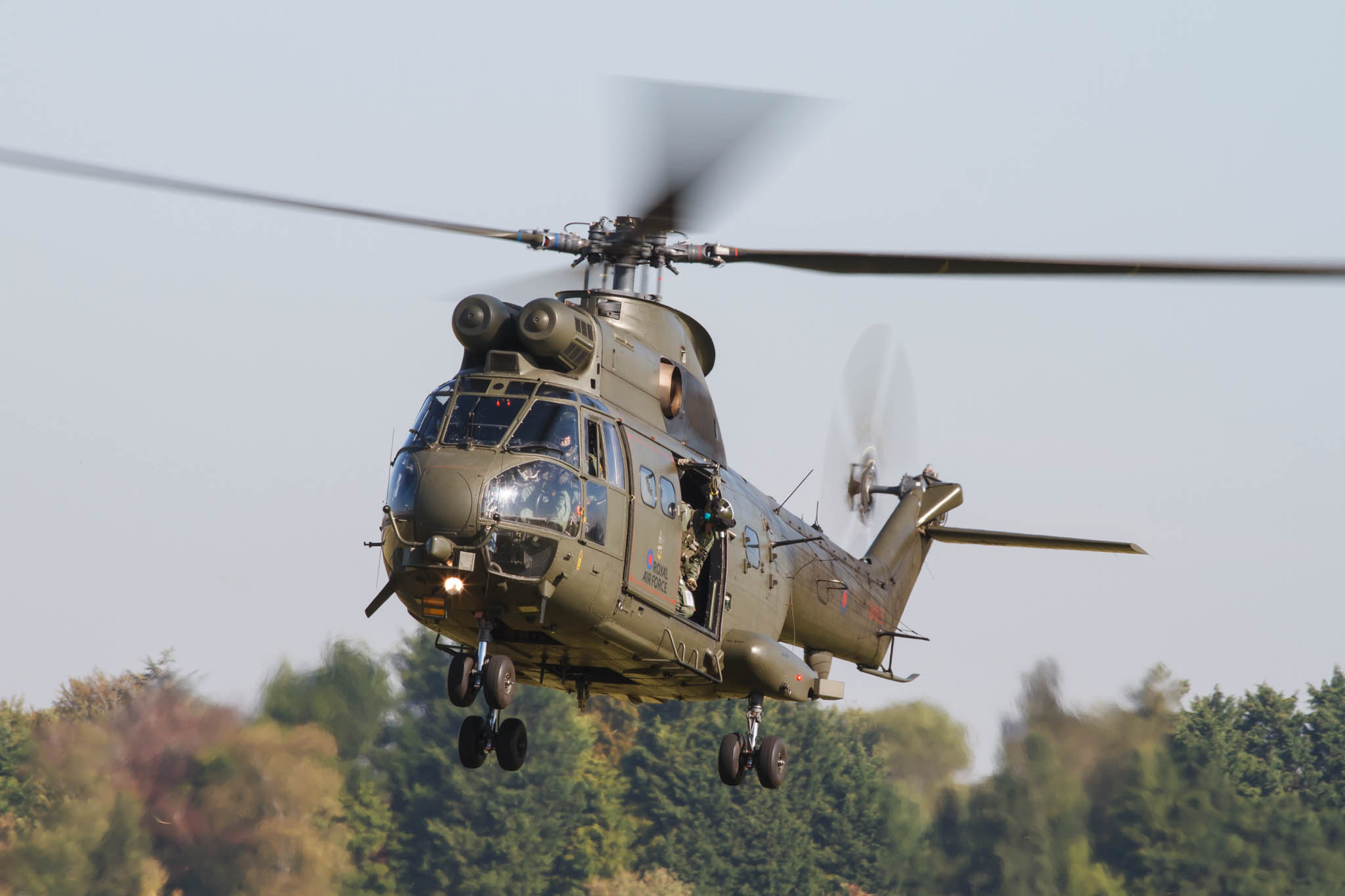 |
| The versatile Puma HC.1, the crewman is feeding information back to the pilot as they come into land |
An Anglo-French collaboration
The SA 330 Puma was originally developed by Sud Aviation (later to become part of Aérospatiale) for the French Army (Armée de Terre), its first flight taking place on April 15, 1965 and deliveries commencing in 1969.
In 1967, the SA.330E Puma was also selected by the RAF and an agreement was signed with Westland Helicopters of Yeovil in Somerset for joint production. The Anglo-French agreement included the production under license by Westland of 292 Aérospatiale SA.341 Gazelle and 40 Westland Lynx by Aérospatiale for the French Navy (Aéronavale).
The first of 48 Westland Puma HC.1 aircraft entered service in 1971 with 33 Squadron then based at RAF Odiham in Hampshire. Two major system upgrades followed the first in 1975 when the DECCA Doppler 71/TANS (Tactical Navigation System) system was fitted. In September 1994, a contract awarded to Racal Avionics for a navigational upgrade comprising a six-channel C/A-code GPS (global positioning system) receiver designated as RNS 252 SUPERTANS. This upgrade replaced the old TANS system was fitted in 41 of the remaining Puma HC.1 the work was completed in 1998. To bolster the Puma fleet in 2002 an additional six SA.330H Puma were acquired by the RAF from the South African Air Force.
Current operations and on-going training
Today as part of Britain’s Joint Helicopter Command (JHC) the RAF’s fleet of Puma are based at RAF Benson in Oxfordshire, operated by 33 and 230 Squadrons which in turn are divided in to five operational flights plus an operational conversion flight. Crews constantly train for every type of mission that they could be tasked for. The Puma Force is always in a state of high readiness as part of the country’s national standby commitment, ready to respond to any unforeseen task or incident at short-notice including compassionate transport or disaster relief.
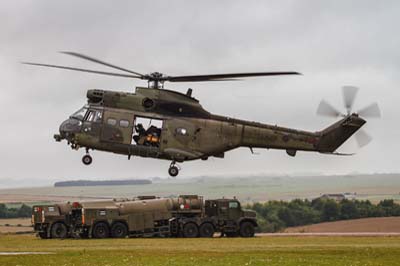 Squadron Leader Steve McCann the 230 Squadron Commander explained how important it is for the aircrew to work as a team and train in every environment especially in time of conflict when flying at extreme low-level; “In a threat environment at low-level there are lots of things to bump into; wires, masts and the terrain. The crewmen will assist with navigation, looking out the window is the most important thing. We are in a seamless loop as a crew; the language is clear and certain”.
Squadron Leader Steve McCann the 230 Squadron Commander explained how important it is for the aircrew to work as a team and train in every environment especially in time of conflict when flying at extreme low-level; “In a threat environment at low-level there are lots of things to bump into; wires, masts and the terrain. The crewmen will assist with navigation, looking out the window is the most important thing. We are in a seamless loop as a crew; the language is clear and certain”.
Puma crews can experience a full range of conditions in which they have to be trained to operate in safely, from ‘hot and high’, to tropical, desert and arctic, each environment has its own dangers requiring extensive training. A Puma pilot speaking of exercises held in Norway; “You need to know what you are doing it is a real threat with temperatures down to minus 30 degrees. White-out caused by snow flurries requires a lot of training similar to those in deserts with dust conditions, for white-out and brown-out the techniques are very similar”. He added; “Arctic conditions are one of the most severe in which to operate, not only for the engineers to operate in, but for aircrew to fly”.
Since November 2009 Pumas from 33 Squadron ‘B’ Flight have been deployed to Kenya under Operation Ascari Thunder to the British Army Training Unit Kenya (BATUK) which operates from the Nanyuki Show Ground. From here they provide support for land force pre-deployment training for Operation Herrick in Afghanistan. Puma Force Commander Grp Cpt Mason, described the training currently being undertaken in Kenya; “We provide training to the British Army and Royal Marine battle groups in Kenya before they go out to Afghanistan. That support is vital you have heard the saying train hard fight easy, when you train hard sometimes troops get injured, Puma is there to pull them out quickly and get them to specialist medical care”.
Flt Lt Andy Bell known as ‘Belly’ is one of the newest members in the Puma Force, joining 33 Squadron as a junior pilot less than six months ago. He has already been deployed under ‘Op Ascari Thunder’. “Kenya is great for us; I have learned what the Puma can actually do regarding its operating envelope; which you don’t really experience in this country”. Commenting on the taskings in Kenya Flt Lt Bell said; “It is a very challenging operating environment you can be ‘hot and high’ one minute and low the next giving you a range of operating performances”. Crews never know what challenges they will come across. Flt Lt Bell remembers one incident well in his short career; “Before army live firing we have to clear the wildlife out the area. I came face to face with a bull elephant during my first range clearing exercise. He was quite stubborn to begin with but after a while we convinced him to leave the area. He was about the same size as us”. |
Puma HC.1s (XW199 and ZA937) participating in a role demo at RAF Benson in September 2011.
Left to right: Troop insertion, disembarking from the helicopter on ground or in the hover by fast rope showing how they can force project in a hurry, followed by troop exfiltration from the battle area.
|
Operations around the world
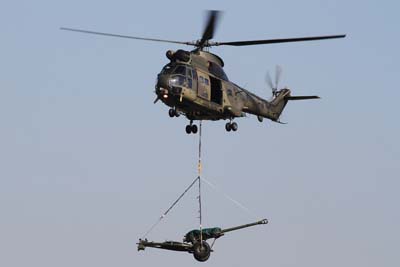 The Puma has performed well in operations around the world providing much needed transport for humanitarian relief to civilians and in times of conflict.
The Puma has performed well in operations around the world providing much needed transport for humanitarian relief to civilians and in times of conflict.
The first Gulf War saw 230 Squadron deployed to Al Jabayl, Saudi Arabia from November 1990 under what was termed Operation Granby by British forces. 33 Squadron Pumas were also deployed to a forward operating base in Iraq. By April 1991 and the end of the war, the Pumas had flown over 1,200 sorties, carried over 4,000 troops and evacuated over 160 casualties. The second Gulf War saw the Puma return to Iraq. From May 2003 till July 2009 230 Squadron operated in Baghdad, Iraq under Operation Telic, which included support for UK Special Forces (22 SAS).
Flight Lieutenant Mike English with 230 Squadron spent a lot of time flying around Iraq. “We have all been shot at in Iraq, you don’t think too much about the consequences as there are lots to think about when flying in a pair at night, wires and masts all around Baghdad. We felt the shots hitting the aircraft to me the chances of being hit yourself seemed remote”.
Belize
The requirement for a Puma deployment in Belize (formally British Honduras) was more prolonged lasting nearly 20 years. 1563 (tactical support) flight was formed with two Puma from 33 Squadron in 1975. After Belize achieved independence in 1981 the UK maintained a deterrent force in the country to protect it from invasion by Guatemala. Pumas provided much need troop transport over the dense tropical jungle, they were known to have supported several SAS operations along the Guatemalan border during the height of the conflict. The British Force Belize (BFB) detachment had also included a force of Harrier jets.
Master Crewman Alan Bosworth who joined 33 Squadron in 1982 and is now an auxiliary recalls his time in Belize; “We re-supplied the troops to very remote locations and OP's (Observation Posts) and also CASEVAC”. In those days it was before the GPS system had been introduced to aid navigation; “Then we used the old fashioned heading and time system using a stop-watch and after say three minutes and 30 seconds look down to where there should be a clearing”.
As with most Puma deployments to areas of conflict the aircraft was available for humanitarian relief. Belize has the second largest barrier reef with lots of tropical islands and a good place for tourists. Master Crewman Bosworth recalled one incident involving of all people an American Greek Orthodox priest who was on holiday. “We were alerted to this chap who had a heart attack on one of the islands; we scrambled, picked him up and got him to a hospital within the hour”. Without such a quick response it would have been many hours before a sailing boat could have collected him.
Ten years on, in 1991 the Guatemalan government finally recognised the self determination of the Belizean people. The main British force was withdrawn in 1994 maintaining a training presence in Belize known as the British Army Training and Support Unit Belize (BATSUB). BATSUB utilised Gazelle and Lynx helicopters, based at Price Barracks, Ladyville and later two 212 Bell Helicopters of 25 Flight Army Air Corps. All flying units were recalled in January 2011.
Northern Ireland
 Under Operation Banner 230 Squadron Puma HC.1 were deployed RAF Aldergrove in Northern Ireland from May 1992 till November 2009 when they were transferred to RAF Benson. Their mission was that of tactical transport for the Security Forces (mostly British Army) either to patrol points or to forward operation bases around the Province.
Under Operation Banner 230 Squadron Puma HC.1 were deployed RAF Aldergrove in Northern Ireland from May 1992 till November 2009 when they were transferred to RAF Benson. Their mission was that of tactical transport for the Security Forces (mostly British Army) either to patrol points or to forward operation bases around the Province.
‘Yavva’ a Squadron Leader who from 1992 had three tours of Northern Ireland, spoke of his time there. “Most of the time our duties were to re-supply the troops. We also assisted the local population with the fixing of aerials to the top of cathedrals and assisting farmers with the rescuing of animals and attending car crashes”. He recalled one story with a smile; “I remember being on standby, it was six o’clock Christmas day morning when we were called out to go to Liverpool hospital to pick up snake bite anti-venom for a local snake breeder who had been bitten by his own snake and knew he had only five hours to live. He survived and we were back in time for Christmas day lunch”.
Flt Lt English arrived in Northern Ireland in 1999 following his tour in Kosovo and for nearly three years flew mostly aviation support missions. During his tour the peace process was underway following the 1998 Good Friday Agreement; “My final tasks were to assist with the taking down of the watch towers and the closing of some of the bases”. He recalled an unprecedented flight to the Republic when during the night he was tasked with flying a four week old baby in an incubator from Enniskillen hospital to Dublin for urgent specialist care; “We got to Enniskillen hospital not realising how big the incubator was going to be, it only just fitted through the door with all the support it needed along with a nurse and doctor. We got clearance to cross the border and fly to Dublin airport where we were met by medical services and the baby was rushed to the hospital”. In those days cross-border relations were still tense. Flt Lt English added; “This sort of mission is what brings down borders, everyone worked together there were no difficulties in getting permission in flying a military aircraft through Republic of Ireland airspace at short notice”. He was obviously pleased to say that he got a letter from the family saying that their baby had survived and was now well.
Trouble in the Balkans
The second half of the 1990’s saw troubles flare up in the Balkans. In August 1995, 33 Squadron were deployed as part of the Rapid Reaction Force (RRF) in an attempt to stabilise the region. Six Pumas were based in Ploce, Croatia and tasked to provide troop lift and airborne command and control. For three months the Squadron conducted flights throughout Croatia, Bosnia and Serbia. With the signing of the Dayton Accord in 1995 the RRF was repatriated in October 1995.
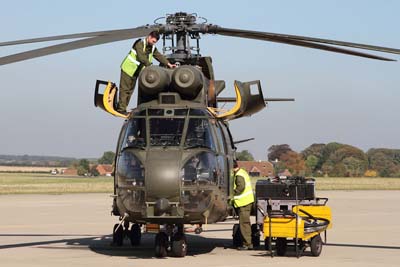 In October 1999, 33 Squadron returned to the Balkans with six Pumas under Operation Agricola to provide helicopter support to NATO forces in Kosovo. The UK had sent 19,000 troops as part of Kosovo Force (KFOR) under the United Nations Security Council Resolution 1244, as Kosovo was facing a humanitarian crisis, with military forces from the Federal Republic of Yugoslavia and the Kosovo Liberation Army in daily engagement. Ethnic tensions were at their highest and the death toll had reached a historic high. Nearly one million people had fled Kosovo as refugees.
In October 1999, 33 Squadron returned to the Balkans with six Pumas under Operation Agricola to provide helicopter support to NATO forces in Kosovo. The UK had sent 19,000 troops as part of Kosovo Force (KFOR) under the United Nations Security Council Resolution 1244, as Kosovo was facing a humanitarian crisis, with military forces from the Federal Republic of Yugoslavia and the Kosovo Liberation Army in daily engagement. Ethnic tensions were at their highest and the death toll had reached a historic high. Nearly one million people had fled Kosovo as refugees.
Kosovo was for Flt Lt English’s first tour on the Puma. “I had a lot of time in Kosovo with the main activity being CASEVAC for British and other Forces, at the time there was no ambulance service”. A significant incident he remembers was when a British Army engineer got hit by a car when he was out for a run smashing his leg badly; “We got out to him urgently and flew him to the American military hospital. Everything went well, he was looked after by his friends who he had been running with, our medics got out to him quickly and decided that he needed to be transported by helicopter, I flew the helicopter to pick him up by stretcher and he was at the hospital within 20 minutes of the accident happening”.
For Flt Lt English Kosovo was primarily about moving troops, which included Norwegian and French, into clear areas as there were lots of minefields out there; “You were never sure where they were located”. He recalled a more unpleasant tasking, the recovery of a Norwegian diplomat who had been blown up by a mine; “We had to recover the body, it was very much a multi-nation operation out there”. The Kosovo Puma deployment ended in November 2001.
Mozambique Floods
In March 2000 Mozambique suffered devastating floods due to heavy rainfall across southern Africa. Helicopters were the only way to rescue people trapped by the floods and distribute aid. Four Puma helicopters from 33 Squadron set off on life-saving missions to help the people of flood-ravaged countryside. During the initial period of Operation Barwood (The UK contribution to the humanitarian operation in Mozambique) from March 5 to 19, the Pumas flew a gruelling 350 hours, airlifted 563 people to safety and distributed 425 tonnes of vital supplies. The Op Barwood deployment ran until April 2000.
Three times the range twice the payload
The RAF currently has a fleet of 34 aircraft available to the JHC. An agreement worth at least £300 million was signed in September 2009 for the upgrade by Eurocopter of 28 RAF Puma helicopters with boosted avionics and improved engines making it more suitable for ‘hot and high’ conditions typically found in Afghanistan. Designated as the HC.2, it will have state-of-the-art cockpit technology and hi-tech communications technology. The new pair of Turbomeca engines should provide 35 per cent additional performance whilst being 25 per cent more fuel efficient than the HC.1 variant. The first reworked Puma made its first flight from Eurocopter’s facility at Marseille-Marignane, south of France on June 24, 2011. It is planned to enter service in 2012, with completion of the contract scheduled for December 2014.
The anticipated Out-of-Service Date (OSD) of the Puma will be increased by ten years making the prospect of a remarkable 50 year anniversary for the Puma a distinct possibility. |
| The normal crew consists of two pilots (or pilot and weapons systems officer) and a crewman. It can carry 16 fully-equipped troops or six stretchers in a CASEVAC role |
| Two cabin-mounted general purpose machine guns can be fitted for use by the crewmen when required. |
Westland Puma HC.1 operational time-line:
33 Squadron
RAF Odiham September 1971 to June 1997
RAF Benson June 1997 to current day
230 Squadron
RAF Odiham October 1971 to September 1980
RAF Gutersloh September 1980 to April 1992
RAF Aldergrove May 1992 to November 2009
RAF Benson November 2009 to current day
|
18 Squadron
Laarbruch/Gutersloh 1992 to 1994
27 Squadron
RAF Odiham 1993 to 1998
72 Squadron
RAF Aldergrove 1997 to 2002
240(OCU)
RAF Odiham 1972 to 1993
1563 Flight
Belize 1981 to 1993 and 2003 to 2009 |

